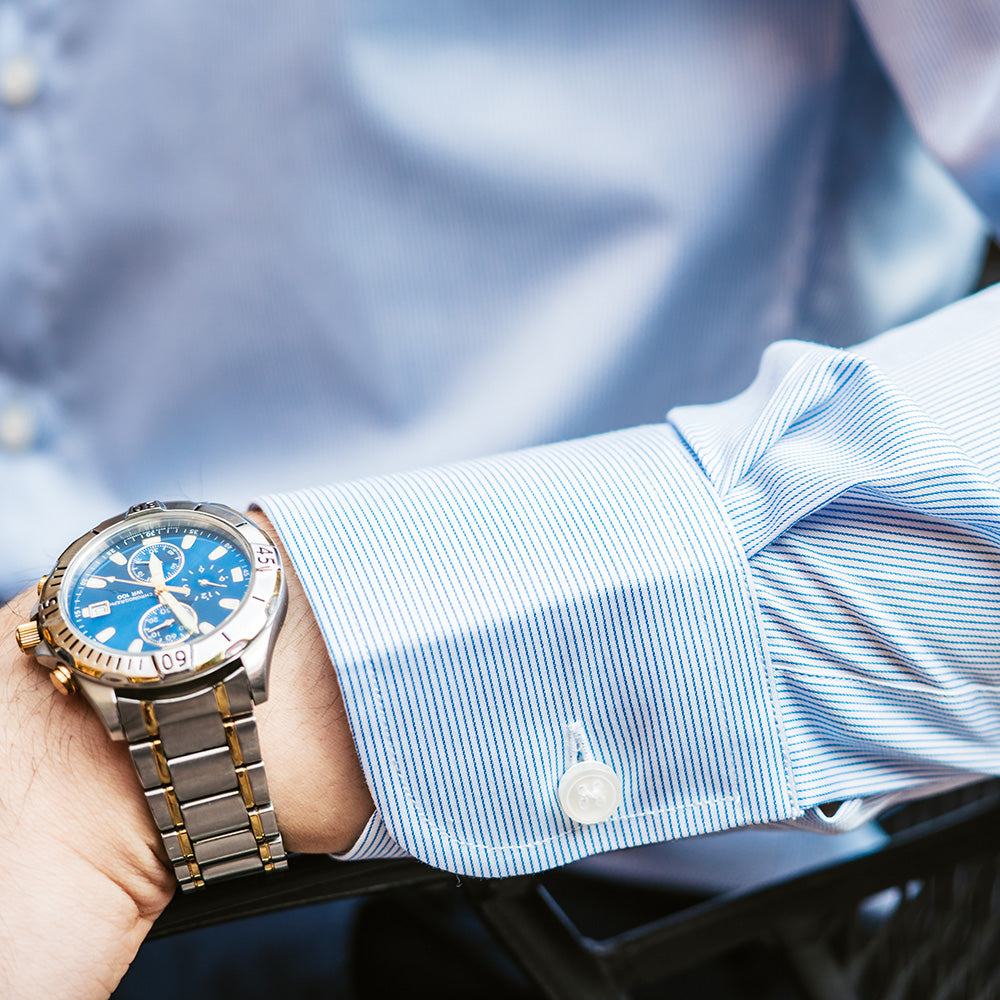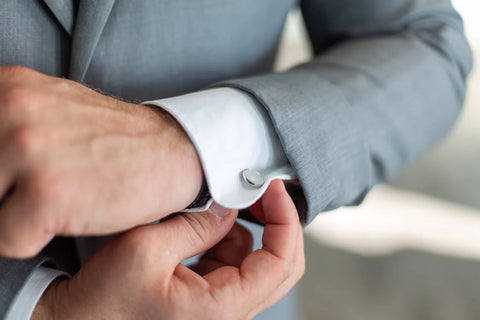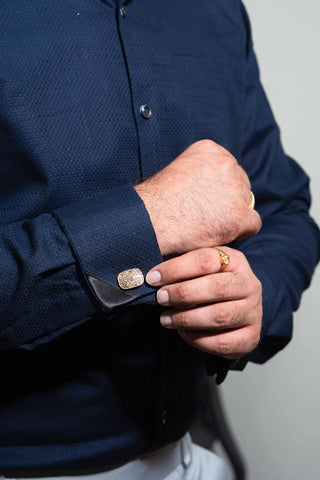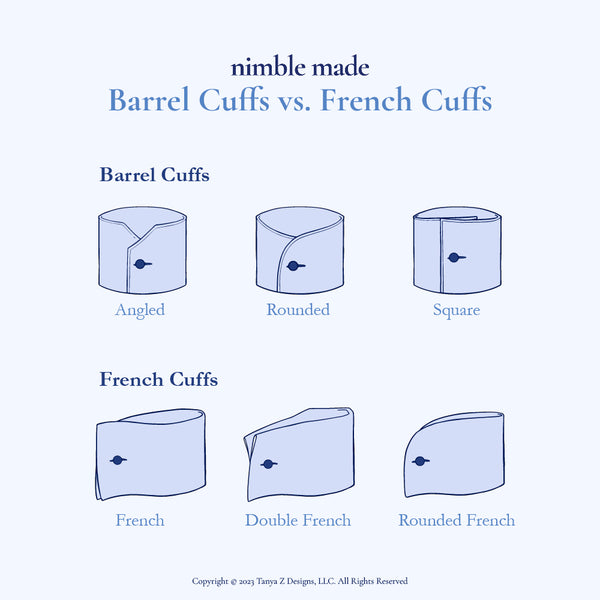
Written by Sonia Su
The often-overlooked detail of shirt cuffs holds significant potential for personal expression and style refinement. From the classic elegance of the French cuff to the laid-back charm of rolled sleeves, the world of shirt cuffs offers various options to suit various occasions and tastes.
This article delves into the diverse styles and functionalities of dress shirt cuffs, providing insights into how this seemingly minor detail can make a major impact on one's overall appearance and fashion statement.
What is a Shirt Cuff?
Shirt cuffs, or simply "cuffs", are the sections of fabric at the end of a dress shirt sleeve that encircle the wrist. They can come in various styles, including barrel cuffs, French cuffs, and convertible cuffs. They serve both functional and aesthetic purposes, providing a finished look to the sleeve while also allowing for adjustments in sleeve length and accommodating accessories such as cufflinks or watches. Browse Nimble Made's extra slim fit dress shirts for your next occasion.

Origins of the Cuff
Early cuffs were often simple and functional, serving the purpose of covering the wrists and providing a finished look to dress shirts.
In the Middle Ages, cuffs were typically detachable and adorned with lace or embroidery as a symbol of wealth and status. As tailoring techniques advanced, cuffs became integral parts of the sleeves of dress shirts, varying in styles from ruffled cuffs in the Renaissance era to more streamlined designs in the Victorian era.
The introduction of cufflinks in the 17th century added a touch of elegance to men's formal attire, further shaping the evolution of cuffs. Today, cuffs come in various styles, from the classic barrel cuff shirt to the sophisticated French cuff shirt, reflecting both tradition and contemporary fashion trends.
How Much a Cuff Should Show
As a general guideline, when wearing a suit or sport coat, around 1/4 to 1/2 inch (0.6 to 1.3 centimeters) of shirt cuff should be visible beyond the jacket sleeve. This subtle peek of cuff adds a polished touch to the ensemble without overpowering the look. For more information, check out our guide on how to measure sleeve length.
However, individuals may adjust this measurement based on their own comfort and aesthetic preferences. Ultimately, the goal is to achieve a balanced and tailored appearance that suits the overall outfit.
Shirt Cuff Styles and Functionalities
Cuffs come in a variety of styles, each with its own unique aesthetic and functionality.
Single Cuff
This one looks like a barrel cuff (more on that cuff later), but it closes in a different way. You can close single cuffs with cufflinks. This cuff type is rarely found off-the-rack due to the fact that they are rare to see worn these days.
There are some small single-cuff style options, but the fit option is more important. Style options—just like with double cuffs—depend on whether it is rounded, square, or angled, although rounded is the default.

The cuff can also have one to three buttons, though you usually only need one button. The same is true regarding sleeves on jackets.
The Italian style places the button on the bottom of the cuffs, closer to the edging. They are also called an open cuff, where the lower position allows your wrist to move more freely. If you’re a man of simplicity and you like the thought of having more freedom in your attire, the single cuff might just be the right style for you.
Cocktail Cuffs
This style of shirt cuff has many names. Some call it the inverted cuff or the James Bond cuff. To others, it’s known as the Portofino or casino cuff. Regardless of the name, if you see the cocktail cuff, it’s sure to stand out to you.
Yes, the cocktail cuff is a rare but spectacular sight, as it is a double-length barrel cuff that is folded in a manner that presents a diagonal hem. Quite eye-catching, to be sure.
Cocktail cuffs have been around long before, but the Bond movie Doctor No caused its rise in popularity. The film starred in the role of James Bond, played by Sean Connery, and has since been accepted as the most popular by cuff connoisseurs. The cocktail cuff is one of the most popular and recognized fashion styles.
Convertible Cuff
Convertible cuff types are not common, and you can only find them in stores that offer customized clothing. Normally, they are a double cuff, but some brands make them similar to the barrel cuff, adding a hole between the buttons.
Barrel Cuffs
A barrel cuff is considered to be the most common type of cuffs and is commonly found in both casual wear and business wear. The design is that of two horizontally spaced buttons with a ¾-inch space between them.
What’s more, there is a specific mark with the buttons arranged vertically. However, you will only see a barrel cuff on tailor-made or popular shirts.
French Cuff/Double Cuff

The length of the French cuff is twice as long as the single cuff. However, these two types of cuffs require the cufflinks to be closed at the wrist. This elegant French cuff style is very popular in the UK. Here are our picks for the best French cuff brands and a more detailed guide to French cuffs.
Its name comes from its style, where the French cuff doubles over itself. The double cuff were one of the most sought-after styles back in the day and remained so until the mid-20th century. This was when it became less popular, and the barrel cuff replaced the double cuff.
There are still many instances when you might want to wear French cuffs, including:
- Gatherings that require a black tie are ideal for French cuffs. They are not only recommended to wear a tuxedo, but also a must. The black-tie event is one of the rare occasions where this cuff is indispensable.
- Business wear and French cuffs are the norm these days. These two go hand-in-hand, and you certainly won’t look out of place sporting them together.
- This French cuff style now incorporates bold patterns and bright colors to suit casual wear, such as casual dress shirts, sports jackets, casual jeans, dark denim, or dress pants. Browse Nimble Made's casual dress shirts.
- At a wedding. Whether you are a guest, groom, or official, double cuff styles will help to add elegance and personality to your overall attire. For more, here is our guide on what to wear to weddings.

- Don’t be afraid to wear a traditional double cuff to a job interview. The French cuff looks good and is suitable for job seekers, especially if you are applying for a senior position in a legal or financial department. If your overall outfit is not matched neatly, you may risk not impressing the interviewer at first sight.
Regardless of the shirt cuff style, shirt cuffs serve to keep the sleeves in place while allowing for ease of movement. They also provide opportunities for personalization and accessorizing, such as with cufflinks, watches, or bracelets. Here is our guide on how to put on and wear cufflinks.
Moreover, certain cuff styles may be better suited for specific occasions or dress codes, allowing individuals to express their personal style while adhering to social norms or expectations.
How to Choose a Shirt Cuff
Here are some tips on how to choose a shirt cuff that suits your needs and enhances your overall appearance.:
-
Personal Style: Consider your personal aesthetic preferences and the overall style of the shirt. For a classic and versatile look, opt for barrel cuffs. If you prefer a more formal and sophisticated appearance, French cuffs may be the ideal choice. For a blend of versatility and elegance, convertible cuffs offer flexibility.

- Occasion: Determine the appropriate dress code for the occasion. Formal events often call for the French cuff, while barrel cuffs are suitable for both casual and business settings. Convertible cuffs provide adaptability, making them suitable for a range of occasions.
- Comfort and Fit: Ensure that the cuffs provide a comfortable fit around the wrist without being too tight or too loose. Consider factors such as sleeve length and cuff circumference to ensure a proper fit that allows for ease of movement.
- Accessorizing: If you enjoy accessorizing your shirts, consider how different cuff styles accommodate accessories such as cufflinks, watches, or bracelets. The French cuff provide an excellent opportunity to wear cufflinks, while barrel cuffs offer simplicity for everyday wear.
- Fabric and Design: Take into account the fabric and design of the shirt when selecting cuffs. Certain fabrics and patterns may complement specific cuff styles better than others. Additionally, pay attention to details such as stitching and cuff shape to ensure they align with your desired look.

How to Fold Men's Dress Shirt Cuffs
Folding cuffs on dress shirts can be done in a few simple steps to achieve a clean and professional look:
- Lay the Shirt Flat: Start by laying the dress shirt flat on a clean, smooth surface, such as a table or ironing board. Ensure that the sleeves are extended and lying straight.
- Button the Cuffs: If the dress shirt has buttons on the cuffs, fasten them to secure the cuff in place. This will make it easier to fold the cuffs neatly.
- Fold Back the Cuff: Fold the cuff back towards the inside of the sleeve. The amount you fold will depend on your preference and the desired length of the sleeve. Typically, folding the cuff back once or twice is sufficient.
- Smooth Out Wrinkles: Smooth out any wrinkles or creases in the fabric to ensure a neat and polished appearance. Press down gently on the folded cuff to flatten it if necessary.
- Repeat on the Other Sleeve: Once you have folded the cuff on one sleeve, repeat the process on the other sleeve to ensure uniformity.

How to Clean White Shirt Collars and Cuffs
Cleaning white collars and cuffs on dress shirts can be done effectively with the following steps to help keep them looking bright and fresh for longer:
- Pre-treatment: Before washing, pre-treat any stains on the collars and cuffs. Apply a stain remover or a mixture of laundry detergent and water directly to the stained areas. Gently rub the solution into the fabric and let it sit for a few minutes to penetrate the stains.
- Soaking: Fill a basin or sink with lukewarm water and add a small amount of laundry detergent or stain remover. Submerge the shirt collar and cuffs in the water and allow them to soak for at least 30 minutes. This helps to loosen dirt and stains from the fabric fibers.
- Hand Washing: After soaking, gently scrub the collars and cuffs with a soft-bristled brush or cloth to remove any remaining stains or dirt. Pay close attention to the edges and seams where dirt tends to accumulate. Rinse the collars and cuffs thoroughly with clean water to remove soap residue.
- Machine Washing: If the shirt is machine washable, launder it in the washing machine according to the care label instructions. Use a gentle cycle and wash the shirt with like colors to prevent color transfer. Add a whitening detergent or bleach alternative to help brighten the white fabric.
- Drying: After washing, air dry the shirt collars and cuffs by laying them flat on a clean towel or drying rack. Avoid drying them in direct sunlight, as this can cause yellowing or fading of the fabric. Alternatively, you can hang the shirt to dry, ensuring that the collars and cuffs retain their shape.
- Ironing: Once dry, iron the collars and cuffs using a steam iron on the appropriate setting for cotton fabric. This helps to smooth out any wrinkles and creases, leaving the collars and cuffs looking crisp and neat.
Browse Nimble Made's collared shirts for your next occasion.

FAQs about Dress Shirt Cuff Styles
What are shirt cuffs called?
Shirt cuffs are typically referred to simply as "cuffs." They are the folded or turned-back portions at the end of a shirt sleeve, often fastened with buttons or cufflinks.
Cuffs come in various styles, such as barrel cuffs, double cuffs, French cuffs, or convertible cuffs, depending on the shirt design and formality.
How do I choose a shirt cuff?
When choosing a shirt cuff, consider both style and functionality. Common options include barrel cuffs, which are versatile and appropriate for most occasions, and the French cuff, which offers a more formal and elegant look, often requiring you to wear cufflinks.
Opt for a style that complements your personal style and the occasion you'll be wearing the shirt for, whether it's a casual outing or a formal event. Additionally, ensure the cuff fits comfortably around your wrist to avoid discomfort or restriction of movement.
What are the rules for shirt cuffs?
Cuffs should extend just past the wrist bone, allowing about half an inch to peek out from under a jacket sleeve. They should fit snugly but not be tight, allowing for movement without slipping over the hand.
Additionally, the cuffs should have enough room to accommodate a watch comfortably, typically with one or two fingers' width of space.
What is cuffing a shirt?
Cuffing a shirt refers to rolling or folding up the sleeves of the shirt, typically to a desired length, for practical or stylistic reasons.
This technique is commonly used to adjust sleeve length for comfort or to showcase accessories like watches or bracelets. Cuffing can also add a casual or relaxed vibe to an outfit.

Comments (0)
Back to News